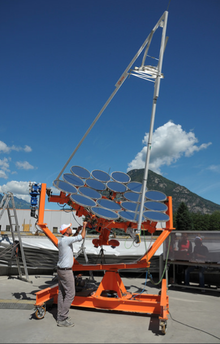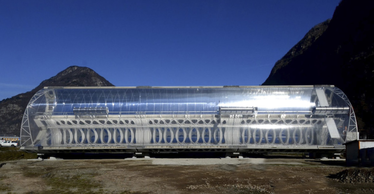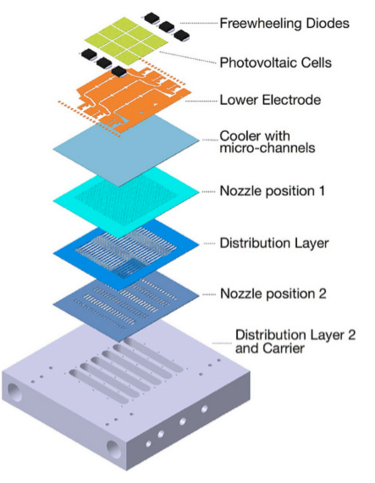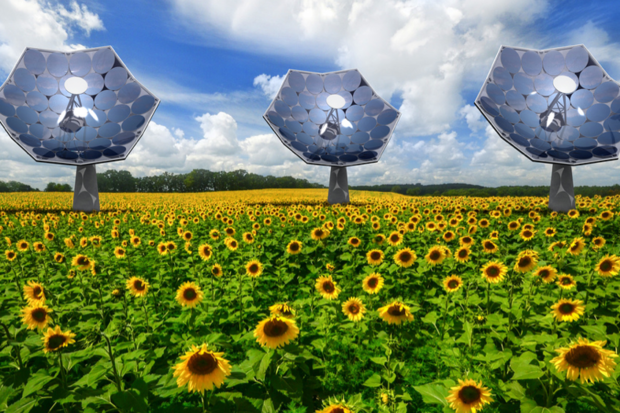IBM Research and Switzerland-based Airlight Energy today announced a new parabolic dish that increases the sun's radiation by 2,000 times while also producing fresh water and air conditioning.
The new Concentrator PhotoVoltaics (CPV) system uses a dense array of water-cooled solar chips that can convert 80% of the sun's radiation into useful energy.
 IBM, Airlight
IBM, Airlight A smaller version of a CPV system.
The CPV, which looks like a 33-foot-high sunflower, can generate 12 kilowatts of electrical power and 20 kilowatts of heat on a sunny day — enough to power several average homes, according to Bruno Michel, the project's lead scientists at IBM Research in Switzerland.
The mirrors concentrate the sun on the chips to produce electricity. Normally, the chips would ignite, since they reach temperatures of 1,500 degrees Celsius. But IBM scientists are taking a page from the supercomputer playbook to keep them at a relatively cool 105 degrees with a water radiator system.
The dense array of multi-junction photovoltaic (PV) chips, mirrors and the electrical receiver are encased in a large inflated transparent plastic enclosure to protect the system from rain or hail.
IBM and Airlight Energy are currently piloting the technology and expect to begin selling it by 2017.
 IBM, Airlight
IBM, Airlight A array of CPV systems surrounded by an inflated transparent plastic enclosure to protect the system from rain or hail.
Ilaria Besozzi, business development manager at Switzerland-based Airlight Energy, said the CPV system will be marketed for urban use and in geographically remote areas. The CPV system is not suitable for rooftop use, as it weighs about 10 tons and is 47 yards square; instead, systems could help power shopping malls or commercial centers, hotels and resorts.
"You're creating a large shadow for cars at a mall, so you're combining two useful things in one," Michel said. "This would be ideal in remote locations where they have high energy costs, such as touristic islands."
CPV systems have been around since the 1970s and use either lenses or curved mirrors to focus sunlight onto a small area of PV cells, increasing the amount of electricity generated.
A common flat panel photovoltaic solar system, like you might find on a rooftop, has a conversion efficiency rating of 15% to 20%. Typically, CPVs magnify the Sun's radiation about 500 times; the IBM/Airlight CPV system magnifies radiation 2,000 times to achieve an 80% efficiency rating.
 IBM, Airlight
IBM, Airlight The actual size of a single solar concentrator.
Because the sun's rays are concentrated onto an array of PV chips, the array needs to be cooled to remain within operating temperatures. The water-filled radiator system that does that also creates hot water that can be used in other ways, such as space heating and air conditioning through an absorption chiller.
The hot water can then be used in an attached desalination system that creates drinkable water by passing itwater through a Gortex-like membrane.
A 40-square meter CPV system could produce up to almost 350 gallons of water a day, according to Besozzi.
 IBM, Airlight
IBM, Airlight The photovoltaic system behind the Concentrator PhotoVoltaics (CPV) system.
"In order to obtain these three separate functions [energy, potable water and a heating or cooling system] you'd need three different products. This is where cost efficiency comes from," Besozzi said.
IBM and Airlight claim the CPV system could provide eight to 10 gallons of drinkable water per square meter of receiver area per day, while still generating electricity with a more than 25% yield or two kilowatt hours per day — "a little less than half the amount of water the average person needs per day."
"A large multi-dish installation could provide enough water for a town," the companies said in their marketing material.
Because it's still in the pilot phase,, the companies are not disclosing prices, Besozzi said. But because the parabolic dish is also constructed of less expensive concrete and aluminum, its cost is four to five times cheaper than comparable systems. Typically, CPV systems are made of glass and aluminum.
The parabolic dish has 36 elliptic mirrors made of 0.2 millimeter thick recyclable aluminum foil with a silver coating. The foil is slightly thicker than a chocolate bar wrapper.
 IBM, Airlight
IBM, Airlight A graphical depiction of the solar concentrator with water cooling system
The photovoltaic chips, similar to those used on orbiting satellites, are mounted on microstructured layers that pipe treated water within a few tens of micrometers of the chip to absorb the heat and draw it away, "10 times more effectively than with passive air cooling," according to IBM.
Based on its current design, IBM scientists estimate that the operating lifetime for the PVT structure is up to 60 years with proper maintenance
Over those six decades, however, the foil and the aluminium elliptic mirrors will need to be replaced every 10 to 15 years depending on the environment. And the photovoltaic cells need replacement every 25 years, the company noted

